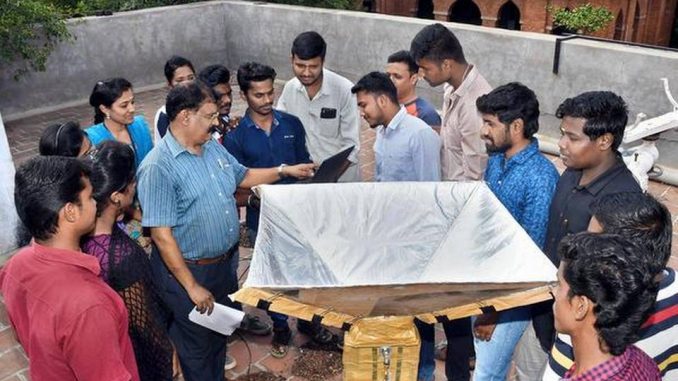
With assistance from Raman Research Institute in Bengaluru
Two research scholars at The American College here have developed a low-cost radio telescope using custom-made components with the help of Raman Research Institute (RRI).
Though the telescope, designed to detect and analyse the Hydrogen Line (also called the 21 centimetre line), was primarily meant for educational purpose and it had the potential to be used for cutting-edge research work, said S. Stephen Inbanathan, a faculty member of the Department of Physics, who guides the two students. The Hydrogen Line refers to the electromagnetic radiation triggered by change in the energy state of hydrogen atoms. “Because of its frequency, this can pass through all interferences in space, including earth’s atmosphere. Hence, this can be used to study these radiations coming from many light years away to better understand out universe,” he said.
The idea to develop the telescope materialised when the two research scholars – B. Arul Pandian and L. Ganesh – visited the RRI in Bengaluru last year as part of a vacation programme. The two said a chance meeting they had with Nimesh A. Patel, an astrophysicist from Harvard-Smithsonian Centre for Astrophysics in the US, who happened to be at RRI at that time, helped in designing the telescope.
“He, along with few others, had developed a low-cost model of radio telescope to detect 21 centimetre line, which he explained to us,” said Mr. Ganesh. With the help of Mr. Patel and T. Prabhu, their guide at RRI, the scholars went a step further to customise it and make it even more cost-effective, Mr. Inbanathan said.
“There was a software component used to analyse and read the signals that has been converted to digital from analog. We used an alternative and easily available software component to do the task,” said Mr. Arul Pandian. They also designed the filter component, used to cut signals in other unwanted frequencies, on their own.
Mr. Inbanathan said the cost of the radio telescope did not exceed ₹ 20,000. Appreciating the two and faculty member, Principal M. Davamani Christober said that the college would plan to make the telescope available to students of other institutions.
[“source=thehindu”]
